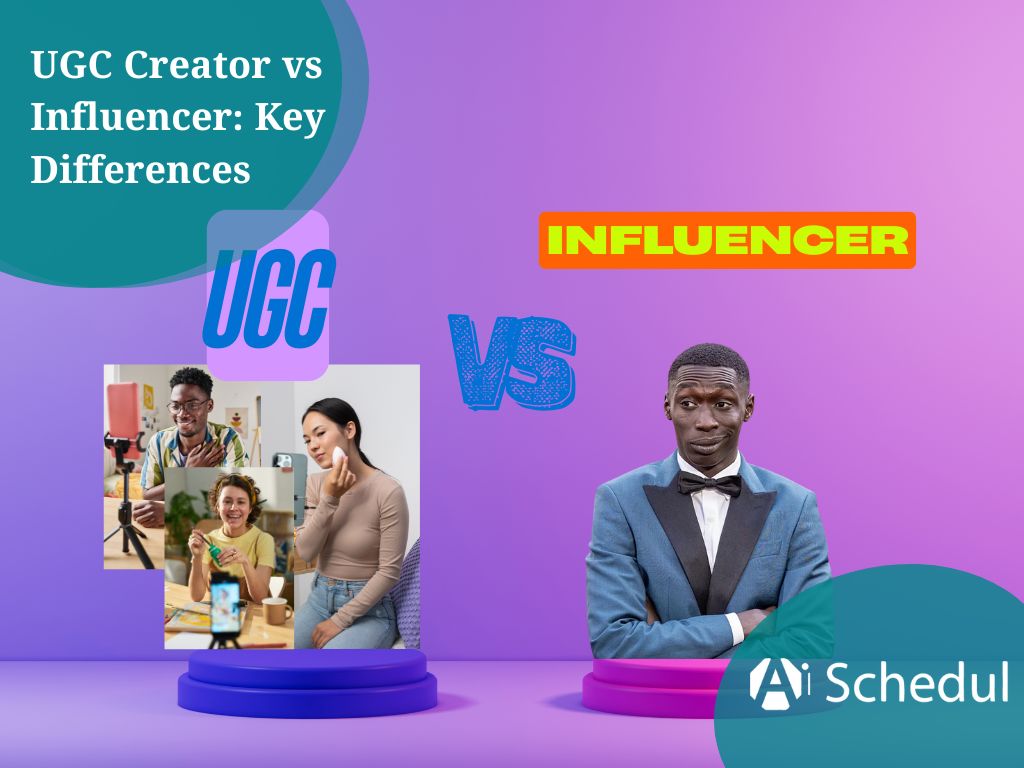The data about UGC and influencer content creates a compelling picture. Influencer marketing is a $21.1 billion industry, and celebrities such as Taylor Swift can demand around $1.6 million per post.
What’s more interesting is that 90% of consumers trust UGC more than influencer content. We’ll break down the differences between UGC vs influencer marketing and explore their differences in depth.
We will compare these two marketing tactics in a way that we hope helps you feel confident about what’s best for your Brand in 2025 and beyond.
Table of Contents
ToggleUGC vs Influencer: What the 2025 Data Tells Us
Research in 2025 provides significant differences between UGC and influencer marketing that every marketer should be aware of.
While micro-influencers have a 6% engagement rate on Instagram (mega-influencers have a 1.97% engagement rate), UGC is seen as about 9x more effective for purchasing decisions.
| Aspect | UGC | Influencer Marketing |
| Trust & Credibility | 90% consumer trust rate | Lower trust compared to UGC |
| Engagement Rate | Not specifically mentioned | Micro-influencers: 6%Mega-influencers: 1.97% |
| Conversion Impact | 9x more effective for purchases161% boost in conversion rates | Lower conversion rates |
| Cost Range | $100-$500 per video | $500-$1500+ per post (50K followers) |
| Content Ownership | Full usage rights for brands | Limited usage rights with restrictions |
| Platform Usage | Primarily brand channels (websites, emails, paid social) | Creator’s own social channels |
| Content Control | High (follows brand guidelines) | Limited (fits creator’s style) |
| Best Use Cases | – Testimonials- Product demos- Reviews- Retargeting | – Product launches- Niche targeting- Initial awareness |
| Click-through Rate | 4x higher than traditional ads | Not specifically mentioned |
| Cost Efficiency | 50% lower cost-per-click | Higher costs overall |
Trust Metrics: Consumers prefer UGC
The gap in trust between UGC vs influencer content is larger than it’s ever been. 90% of consumers trust UGC content more than influencer content.
On top of that, 86% of shoppers trust brands that post real customer content over paid brand posts. This is why we see many brands changing their approach.
Knowing how to become a UGC creator has become one of those skills, since authenticity continues to reign in consumer-favoured content.
Engagement Rates: Micro-Influencers vs UGC Creators
When evaluating engagement metrics, the comparisons between UGC vs influencer content are revealing.
Specifically, micro-influencers who have a following of approximately 5,000 followers have a strong engagement rate of 5%, compared with celebrity influencers who experience an engagement rate of just 2.2%.
Moreover, nano-influencers see engagement over UGC in rates between 6.15% and 6.76%. Knowing the best time to post on Instagram could also help improve engagement rates for UGC and influencers.
Conversion Impact: UGC Drives More Conversions
Where UGC vs influencer marketing truly diverges is in conversion power. UGC is perceived as almost 9 times more effective for purchase decisions.
Moreover, campaigns featuring user content enjoy a remarkable 161% boost in conversion rates.
Also, for creators who wonder how to make money on TikTok, user-generated content (UGC)-based ads average 4x higher click-through rates than other ad types, and also cut cost-per-click by 50%.
Cost Efficiency: UGC Creators Charge Less
Statistics related to UGC vs influencer costs are significantly different. UGC creators will typically charge around $100-$500 per video, while influencers with 50K followers charge $500-$1500+ per post.
Here is a table showing the cost differences in 2025:
| Content Type | Price Range | What You Get |
| UGC Video | $150-$300 | Content only |
| Influencer Post (50K) | $500-$1500+ | Content + audience |
With these price ranges, knowing how to make money on Instagram is a must for UGC creators.
UGC vs Influencer: Key Differences

Outside of the metrics explaining value, the basic structural difference of UGC vs influencer marketing shapes how these strategies work. Knowing the distinctions helps brands pull the correct lever for their situation.
Content Ownership: Brand-Owned vs Creator-Owned
The ownership model is different in the UGC vs influencer world. With UGC, the brand generally owns all usage rights to the ads and creatives created just for their brand.
Influencer content usually comes with usage restrictions and time frames that require negotiation.
The distinction is important because brands are thinking about the possible reuse of content over time across multiple channels.
Audience Reach: Organic UGC vs Influencer Follower Base
In terms of audience access, UGC vs influencer marketing natively serve different purposes.
UGC is better suited to lower funnel moments like retargeting and product detail pages, as influencer marketing lacks built-in access to an audience, but builds from grassroots credibility.
On the other hand, influencer content provides immediate access to curated audiences and capitalizes on the creator’s existing credibility.
Control Over Messaging: Scripted vs Spontaneous Content
Brands have more control over UGC creators who are creating based on a brief or script that aligns with the brand’s strategy.
This structured approach allows key audience messages to be communicated effectively while giving the audience a sense of real & authentic content.
In contrast, influencer content is more relevant to the creator’s style and aesthetic, which reduces the brand’s control level once published.
Platform Usage: Brand Channels vs Creator Channels
The difference in platforms really separates these strategies. UGC content primarily lives on brand channels – website, email, and paid social.
Essentially, UGC presenters are an extension of commercial actors creating organic–looking content without sharing it with their followers.
When to Use UGC, Influencer Marketing, or Both
Determining when to use UGC or influencer marketing really depends on your business goals and campaign objectives.
In a competitive marketplace in 2025, it makes all the difference to implement a marketing strategy.
Best Use Cases for UGC: Testimonials, Product Demos & Reviews
- UGC is most valuable when you need to create authentic social proof.
- Use it in conversion and retargeting–focused campaigns
- Use it in testimonials and demonstrations to sway purchase decisions.
- UGC is also helpful for A/B testing versatile assets
- Voices on product pages for effective merchandising.
UGC can also help you create a scalable content library for paid social media, email marketing, and website content.
Best Use Cases for Influencers: Product Launches, Niche Targeting
Influencers excel at generating immediate buzz around new product launches and campaigns.
They’re ideal when you need to reach specific target audiences quickly, especially when entering new markets. Notably, influencers create top-of-funnel excitement while delivering third-party validation.
Their established credibility helps brands instantly tap into communities with shared values, making influencer activations perfect for initial awareness phases.
Hybrid Strategy: Influencer-Generated UGC for Paid Ads
The most powerful approach often combines both strategies. Influencer-generated content creates a complementary ecosystem where influencers build awareness while UGC drives action.
For instance, brands can partner with influencers to launch UGC contests where followers participate by creating content.
This approach helps you gain exposure quickly while implementing both user and influencer content in your brand strategy.
Campaign Goals: Awareness, Trust & Conversions
Your campaign objectives should dictate your content strategy:
| Campaign Goal | Best Strategy | Why It Works |
| Awareness | Influencers | Immediate visibility through established audiences |
| Trust | UGC | 79% say UGC highly impacts purchasing decisions |
| Conversions | Hybrid/UGC | UGC in ads achieves 4x higher click-through rates |
For awareness, use influencers to reach new audiences.
For building trust, leverage authentic UGC.
Challenges & Solutions in UGC & Influencer Campaigns

UGC and influencer campaigns both come with their own obstacles that affect how well they work. Learning these obstacles and the answers to them allows marketers to get the most out of whatever approach they may use.
Scaling UGC: How to Encourage More Customer Content
Getting enough quality UGC is still a challenge in the UGC vs influencer discussion. Many brands ask customers to “tag us” to only receive random, low-quality takes. The answer?
Instead of being vague, you should provide specific templates, instead. Instead of asking for some general UGC, give customers some of the following:
- Specific requests (“Send a 10-second video unboxing”)
- Examples of successful submissions
- Simple guidelines for quality content
- Light incentives like reposts or recognition
This structured approach increased content quality and boosted UGC production by 30% for some brands.
Content Rights: Legal Considerations & Permission Templates
Many people assume that social media posts are legally “free” for commercial use, including for products featured, but this is not true.
Once a creator posts content on social media, the creator has copyright in that image. Always get permission with a simple template:
“Hi [Creator’s Name], I’m [Name] from [Brand Name]. We love your content and want to feature it on our [Website/Social Media/Ads]. Would you be open to that?”
Understanding rights becomes crucial due to the platform’s terms of service and commercial usage laws.
Authenticity vs Incentivization: Avoiding Over-Commercialization
Another one of the UGC vs influencer dilemmas is balancing the use of incentives without losing authenticity.
Authentic content will almost always beat overly promotional content. Keep these in mind when incentivizing influencer content:
| Incentive Type | Authenticity Impact | Best Practices |
| Recognition | High | Feature creators on brand channels |
| Discounts | Medium | Offer without dictating content |
| Monetary | Variable | Prioritize passionate customers |
The key? Frame participation as a celebration rather than marketing.
Measuring ROI: Attribution Models for UGC & influencer Content
Tracking true ROI beyond vanity metrics remains difficult in both UGC and influencer marketing. The solution involves measuring different metrics for different goals:
- Awareness: impressions, video views, engagement
- Consideration: click-through rates, time on site
- Conversion: affiliate links, discount codes, direct revenue
A thorough approach to analyzing data across the funnel allows you to actually understand the real business impact, versus just an influence on the sales end.
Many brands will have an influencer marketing platform that shares reporting in real-time.
An example of this was a skincare brand that generated $1.00M in sales after a proper attribution model took place.
Which One to Pick
Choosing UGC or influencer marketing depends on your brand goals.
UGC provides better trust and conversions, as 90% of consumers trust content from a real customer. This trust averages 161% higher conversion rates than a traditional level of trust.
Whereas influencers excel at generating immediate awareness when brands launch products or enter new markets.
Top brands are using a hybrid, or combined, approach. They reach their target audience at the top of the funnel with influencers and engage them authentically with UGC engagement that converts.
UGC is also 60% to 80% less expensive and creates higher trust.
UGC vs Influencer: FAQs
1. Can UGC be faceless?
Sure! Faceless, lo-fi UGC (think raw Reels/TikToks/Shorts) works well — by 2025, audiences reward content that feels authentic and local as opposed to polished ads.
2. Is UGC the same as content creator work?
No. UGC is authentic content created by actual customers who are not being compensated or sponsored; creator/influencer content is created as part of a commercial arrangement, which inherently carries a marketing component.
3. What’s the difference between UGC and a collaboration?
UGC is unpaid and organic feedback from consumers. A collaboration is a business agreement with a creator (paid or gifted). Paid collaboration involves a payment to the creator (plus taxes/reporting responsibilities), while gifted collaborations are an exchange of product for content.

